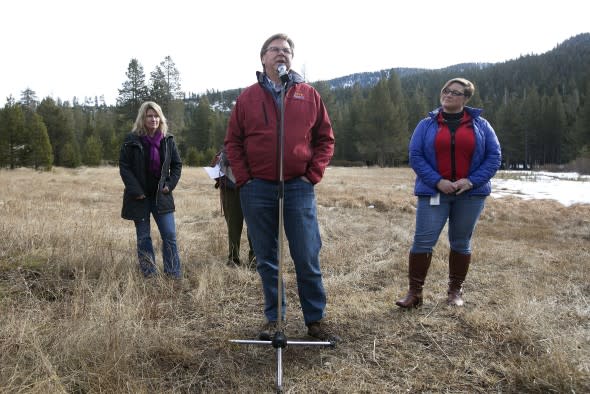What do shrinking snowpack, warmer winters spell for western US water supply?
The majority of the western United States relies on snowpack, which produces snowmelt, for its water supply.
Snowpack is the snow that falls and remains on the ground, not melting until temperatures rise. During the colder months, the snowpack accumulates and stores water, which is later released when weather conditions are drier and warmer.
In addition to supplying drinking water, the snowpack in states including California and Nevada is an integral source of ecosystem services and recreation.
Snowmelt from the Colorado River Basin contributes about 70 percent of total water supplies for more than half of Southern California and most of southern Nevada, according to the California-Nevada Climate Applications Program. Its low salt content makes snowmelt a useful fresh water source of drinking supplies.

In this Wednesday, Jan. 3, 2018 file photo, Grant Davis, director of the Department of Water Resources, center, discusses the results of the first snow survey of the season at the nearly snow-barren Phillips Station snow course near Echo Summit, California. (AP Photo/Rich Pedroncelli, File)
With increasingly warmer winters and a diminishing snowpack in recent years, the lack of snowmelt might pose problems for the communities that need it.
Measurements of the Sierra Nevada snowpack in early spring 2018 revealed that the snowpack remained below normal.
"We've seen the typical elevation at which rain transitions into snow, on average, go up over the past decade," said Nina Oakley, a regional climatologist at the Desert Research Institute's Western Regional Climate Center in Reno, Nevada.
"Now, we're seeing less snowpack building, and it's been observed in the West that with warmer spring temperatures, we're seeing earlier spring snowmelt runoff," Oakley said.
A 2017 report from the National Center for Atmospheric Research showed that warmer winters are causing mountain snowpack to melt both earlier and slower. This is due to less thawing occurring during the lengthier nights and weak sunlight of early spring, according to Colorado Public Radio News.
University of Nevada researchers have reported that the cause of less efficient snowmelt runoff is that "slower snowmelt reduces the amount of moisture being pushed deep into the subsurface, where it is less likely to evaporate."
Researchers believe one effect of slower snowmelt on water supply and hydropower production could be that the snowmelt will move less efficiently downstream to reservoirs at times when it's especially needed, such as during drier periods.
The role of reservoirs
In the West, reservoirs are used for both flood control and for water storage, and during the winter months, those reservoirs take on their flood control capacity, according to Oakley.
"They keep the reservoirs at lower storage levels so that there is space for when we have a big, heavy precipitation event for that water to run off into the reservoir and not go downstream and have flood impacts," Oakley said.
During summer, when flooding is less of an issue in the western United States, reservoirs will have a higher capacity, she said. "It's important that we can have that flood control capacity [because] we're counting on snowpack runoff in the spring and summer to fill up the reservoirs at a time that we're not as vulnerable to floods," Oakley said.
She added that lots of snowfall followed by rapid warming, or a rain-on-snow event that drops warm rain on top of snow, can cause significant flooding along rivers coming out of snow-fed areas.
In 2017, according to Oakley, rain-on-snow events or rapidly warming springtime conditions in the West resulted in quick-melting snowpacks in some areas, damaging homes and businesses along nearby rivers. These rapid rises in rivers are dangerous for those participating in recreational activities.
"People that might be kayaking or playing down by the river, especially in the springtime as daytime temperatures get really high and cool off at night, the rivers can rise and fall really quickly, [creating hazards for people nearby]," she said.
"Those are interesting impacts that we saw in 2017 along many areas of the West - our big snowpack and warm spring temperatures," Oakley said.
"When our summer water supply is not great, these reservoirs are really low," said Kathie Dello, associate director of the Oregon Climate Change Research Institute.
"A lot of communities around them rely on them for recreation, so people aren't showing up to the towns and spending money, and you're seeing the impacts cascade through the economy,"
In 2015, Oregon's Detroit Lake, popular for boaters, showed stark signs of drought conditions at the start of boating season.
As winters continue to warm, thinking about climate adaptation is key, said Dello.
"A lot of people are moving to the West, so we have to think about our long-term water supply, potentially different types of storage or different ways of accessing and allocating the water," Dello said.
The declining snowpack doesn't necessarily mean that each passing year will have a smaller snowpack, nor does it mean that the warming trend will stop the occurrence of cold storms, said Oakley.
"On average, in the future, we'll see a shrinking snowpack that is more confined to higher elevations," she said.
